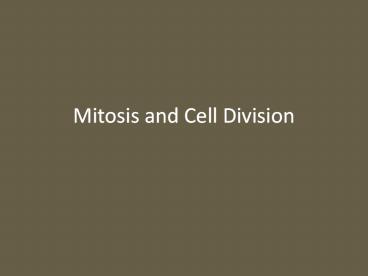Mitosis and Cell Division - PowerPoint PPT Presentation
Title:
Mitosis and Cell Division
Description:
Mitosis and Cell Division Chromatin What organelle is DNA found in? Before the cell prepares to divide, DNA looks like a jumbled mess Chromatin Up close, we can ... – PowerPoint PPT presentation
Number of Views:786
Avg rating:3.0/5.0
Title: Mitosis and Cell Division
1
Mitosis and Cell Division
2
Chromatin
- What organelle is DNA found in?
- Before the cell prepares to divide, DNA looks
like a jumbled mess
3
Chromatin
- Up close, we can see that it is a little more
organized - DNA is wrapped around Histone proteins. Each unit
of histone and DNA is called a Nucleosome.
4
Chromosomes
- When you are getting ready to move, what do you
do with all of your things? - Before cell division, DNA must be transformed
into a more compact and moveable form.
5
Chromosome Structure
Centromeres are the pinched center of the
chromosome. When the chromosomes replicate in
order to prepare for cell division, the
centromere will hold the two sister chromatids
together.
6
Chromosome Structure
In order to identify the placement of genes on a
chromosome, the top is labeled the p region,
and the bottom is labeled the q region
7
Chromosome Structure
8
ALL CELLS COME FROM PRE-EXISTING CELLS
- If this is true, how do we get new cells?
9
Cell Cycle
- Regular pattern of growth, DNA duplication, and
cell division that occurs in eukaryotic cells
10
Cell Cycle
- Cells spend most of their time in Interphase,
which is the time before and after cell division.
During this time, the cell is preparing for
division.
Interphase has three stages Gap 1 (G1) cell
carries out normal functions and undergoes normal
growth CHECKPOINT Synthesis (S) DNA is
replicated and another CHECKPOINT occurs Gap 2
(G2) the cell continues to grow and
another CHECKPOINT must be passed that insures
the cell is of adequate size and carries
UNDAMAGED DNA in order to begin cell
division The actual process of Cell Division is
called MITOSIS
11
MITOSIS
- Mitosis divides the cell nucleus and its contents
(which are?) - CYTOKINESIS divides the ________ and follows or
occurs simultaneously
12
STAGES OF MITOSIS
13
Interphase This is the longest period of the complete cell cycle during which DNA replicates, the centrioles divide, and proteins are actively produced.
Prophase The nucleolus fades and chromatin (replicated DNA and associated proteins) condenses into chromosomes. Microtubules of the cytoskeleton, responsible for cell shape, motility and attachment to other cells during interphase, disassemble. The building blocks of these microtubules are used to grow the mitotic spindle from the region of the centrosomes.
Pro-Metaphase The nuclear envelope breaks down so there is no longer a recognizable nucleus. Some mitotic spindle fibers elongate from the centrosomes and attach to kinetochores, protein bundles at the centromere region on the chromosomes where sister chromatids are joined. Other spindle fibers elongate but instead of attaching to chromosomes, overlap each other at the cell center.
Metaphase Tension applied by the spindle fibers aligns all chromosomes in one plane at the center of the cell.
Anaphase Spindle fibers shorten, the kinetochores separate, and the chromatids (daughter chromosomes) are pulled apart and begin moving to the cell poles.
Telophase Cytokinesis The daughter chromosomes arrive at the poles and the spindle fibers that have pulled them apart disappear. The spindle fibers not attached to chromosomes begin breaking down until only that portion of overlap is left. It is in this region that a contractile ring cleaves the cell into two daughter cells. Microtubules then reorganize into a new cytoskeleton for the return to interphase.
14
STAGES OF MITOSIS
15
(No Transcript)
16
Cell Growth Regulation
- External factors
- cell-cell contact
- growth factors
- hormones
- Internal factors
- cyclin activated kinases
- Apoptosis
17
Uncontrolled cell growth is Cancer
- CHARACTERISTICS OF CANCER CELLS
- Lost the ability to stop dividing
- Immortal
- Not subject to contact inhibition
- Metastasize
- Dedifferentiated
18
Cancer Vocabulary
- Benign a cancer tumor that remains clustered
together - Malignant a cancer tumor that has cells that are
breaking away - Carcinogens Cancer causing agents
19
- Aflatoxins
- Alcoholic beverage consumption
- 4-Aminobiphenyl
- Analgesic mixtures containing phenacetin
- Aristolochic acids
- Arsenic compounds, inorganic
- Asbestos
- Azathioprine
- Benzene
- Benzidine
- Beryllium and beryllium compounds
- 1,3-Butadiene
- 1,4-Butanediol dimethylsulfonate (busulfan,
Myleran) - Cadmium and cadmium compounds
- Chlorambucil
- 1-(2-Chloroethyl)-3-(4-methylcyclohexyl)-1-nit
rosourea (MeCCNU) - bis(chloromethyl) ether and technical-grade
chloromethyl methyl ether
KNOWN HUMAN CARCINOGENS
Chromium hexavalent compounds Coal tar
pitches Coal tars Coke oven emissions
Cyclophosphamide Cyclosporin A
Diethylstilbestrol (DES) Dyes metabolized to
benzidine Environmental tobacco smoke
Erionite Estrogens, steroidal Ethylene
oxide Formaldehyde Hepatitis B virus
Hepatitis C virus Human papilloma viruses
some genital-mucosal types Melphalan
Methoxsalen with ultraviolet A therapy (PUVA)
Mineral oils (untreated and mildly treated)
Mustard gas
2-Naphthylamine Neutrons Nickel
compounds Oral tobacco products Radon
Silica, crystalline (respirable size) Solar
radiation Soots Strong inorganic acid
mists containing sulfuric acid Sunlamps or
sunbeds, exposure to Tamoxifen
2,3,7,8-Tetrachlorodibenzo-p-dioxin (TCDD)
"dioxin" Thiotepa Thorium dioxide
Tobacco smoking Vinyl chloride
Ultraviolet radiation, broad spectrum UV
radiation Wood dust X-radiation and gamma
radiation
20
ASEXUAL REPRODUCTION
- Advantages and Disadvantages
21
ASEXUAL REPRODUCTIONBudding, Fragmentation,
Binary Fission, Sporolation, Vegetative
Reproduction































